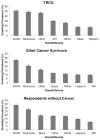Persistent cigarette smoking and other tobacco use after a tobacco-related cancer diagnosis
- PMID: 22706885
- PMCID: PMC4591959
- DOI: 10.1007/s11764-012-0230-1
Persistent cigarette smoking and other tobacco use after a tobacco-related cancer diagnosis
Abstract
Introduction: People who continue to smoke after a cancer diagnosis have an increased risk for recurrences or development of new malignancies. These risks may be even higher among tobacco-related cancer survivors (TRCS). We describe tobacco use behaviors among TRCS, other cancer survivors, and people without a history of cancer.
Methods: We used 2009 Behavioral Risk Factor Surveillance System data to describe demographic characteristics, smoking history, current smoking prevalence, and smokeless tobacco use among TRCS, other cancer survivors, and people without a history of cancer (cigarette smoking and smokeless tobacco use were calculated after adjusting for age, sex, race, and insurance status). Tobacco-related cancers were defined as lung/bronchial, pharyngeal, laryngeal, esophageal, stomach, pancreatic, kidney/renal, urinary bladder, cervical, and acute myeloid leukemia.
Results: A total of 20 % of all cancer survivors were TRCS. TRCS were primarily female (68 %) and white (78 %). Smoking prevalence was higher among TRCS (27 %) compared with other cancer survivors (16 %) and respondents without a history of cancer (18 %). Smokeless tobacco use was higher among respondents without a history of cancer (4 %) compared with TRCS (3 %) and other cancer survivors (3 %).
Conclusions: The self-reported smoking prevalence among TRCS is higher than among other cancer survivors and people without a history of cancer. Targeted smoking prevention and cessation interventions are needed for cancer survivors, especially those diagnosed with a tobacco-related cancer.
Implications for cancer survivors: We recommend all cancer survivors be made aware of the health risks associated with smoking after a cancer diagnosis, and smoking cessation services be offered to those who currently smoke. We provide the first population-based report on demographic characteristics and tobacco use behaviors among self-reported tobacco-related cancer survivors.
Figures





Similar articles
-
Surveillance for selected tobacco-use behaviors--United States, 1900-1994.MMWR CDC Surveill Summ. 1994 Nov 18;43(3):1-43. MMWR CDC Surveill Summ. 1994. PMID: 7969014
-
Likelihood of Smoking Among Cancer Survivors: An Updated Health Information National Trends Survey Analysis.Nicotine Tob Res. 2019 Nov 19;21(12):1636-1643. doi: 10.1093/ntr/ntz007. Nicotine Tob Res. 2019. PMID: 30843035
-
Surveillance of demographic characteristics and health behaviors among adult cancer survivors--Behavioral Risk Factor Surveillance System, United States, 2009.MMWR Surveill Summ. 2012 Jan 20;61(1):1-23. MMWR Surveill Summ. 2012. PMID: 22258477
-
Health effects of tobacco use and exposure.Monaldi Arch Chest Dis. 2001 Dec;56(6):545-54. Monaldi Arch Chest Dis. 2001. PMID: 11980288 Review.
-
The epidemiology of tobacco use, dependence, and cessation in the United States.Prim Care. 1999 Sep;26(3):433-61. doi: 10.1016/s0095-4543(05)70112-3. Prim Care. 1999. PMID: 10436282 Review.
Cited by
-
Smoking Behaviors in Survivors of Smoking-Related and Non-Smoking-Related Cancers.JAMA Netw Open. 2020 Jul 1;3(7):e209072. doi: 10.1001/jamanetworkopen.2020.9072. JAMA Netw Open. 2020. PMID: 32614423 Free PMC article.
-
Identifying Smoking Status and Smoking Cessation Using a Data Linkage Between the Kentucky Cancer Registry and Health Claims Data.JCO Clin Cancer Inform. 2019 May;3:1-8. doi: 10.1200/CCI.19.00011. JCO Clin Cancer Inform. 2019. PMID: 31095418 Free PMC article.
-
Smoking Cessation after Cancer Diagnosis and Enhanced Therapy Response: Mechanisms and Significance.Curr Oncol. 2022 Dec 17;29(12):9956-9969. doi: 10.3390/curroncol29120782. Curr Oncol. 2022. PMID: 36547196 Free PMC article. Review.
-
Modifiable health-related factors (smoking, physical activity and body mass index) and health care use and costs among adult cancer survivors.J Cancer Res Clin Oncol. 2017 Dec;143(12):2469-2480. doi: 10.1007/s00432-017-2494-3. Epub 2017 Aug 22. J Cancer Res Clin Oncol. 2017. PMID: 28831650 Free PMC article.
-
Smoking cessation among men following cancer diagnosis: a matched cohort study.J Cancer Surviv. 2018 Dec;12(6):786-793. doi: 10.1007/s11764-018-0715-7. Epub 2018 Oct 9. J Cancer Surviv. 2018. PMID: 30302603
References
-
- Centers for Disease Control and Prevention. Cancer Survivors—United States, 2007. MMWR Morb Mortal Wkly Rep. 2011;60:269–272. - PubMed
-
- Fairley TL, Pollack LA, Moore AR, Smith JL. Addressing cancer survivorship through public health: an update from the Centers for Disease Control and Prevention. J Womens Health (Larchmt) 2009;18(10):1525–31. - PubMed
-
- Coups EJ, Ostroff JS. A population-based estimate of the prevalence of behavioral risk factors among adult cancer survivors and noncancer controls. Prev Med. 2005;40(6):702–11. - PubMed
-
- Pollack LA, Rowland JH, Crammer C, Stefanek M. Introduction: charting the landscape of cancer survivors’ health-related outcomes and care. Cancer. 2009;115(18 Suppl):4265–9. - PubMed
MeSH terms
Grants and funding
LinkOut - more resources
Full Text Sources
Medical

